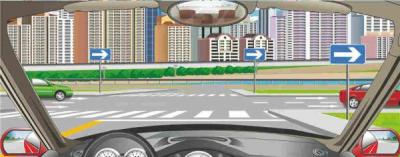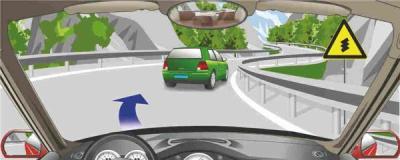1、The driver should take emergency evasion measures when the motor vehicle suddenly self-ignites. Which ones of the following methods are correct?
A、Spray clean water to extinguish the fire
B、Report to the police
C、Use the spare fire extinguisher in the vehicle to put out the fire
D、Set up a warning sign in the oncoming direction
Answer:BCD
2、Motor vehicles are not permitted to change lanes in this position.

A、Right
B、Wrong
Answer:A
3、The sign on the right warns of a narrowed road on both sides ahead.

A、Right
B、Wrong
Answer:B
4、The guide arrow on the road surface of this lane indicates that there is an intersection on the right side of the road.

A、Right
B、Wrong
Answer:B
5、The sign in front indicates a one-way lane after turning right.

A、Right
B、Wrong
Answer:A
6、The sign on the right indicates a 2-kilometer distance from the Donglushan Service Area on the highway.

A、Right
B、Wrong
Answer:A
7、It is safest for a motor vehicle driver to overtake the vehicle in front from its righthand on this kind of road.

A、Right
B、Wrong
Answer:B
8、When driving a vehicle equipped with power steering what should the driver do upon finding that steering is difficult?
A、Stop and identify the cause
B、Control the steering and drive slowly
C、Drive at a lower speed
D、Keep the vehicle going straight
Answer:A
9、Which of the following method is correct to rescue an unconscious person?
A、Apply cardio-pulmonaryresuscitation immediately
B、Press the philtrum of the wounded person with force
C、Continuously slap the face of the wounded person
D、Check the breath of the wounded person before other emergency treatments
Answer:D
10、Which lamp should be turned on when motor vehicles pass through a road section at night where the street light condition is good?
A、Front and rear fog lamps
B、Low-beam
C、High-beam
D、Hazard lamp
Answer:B
11、The sign on the right warns of no passing due to collapse on the road ahead.

A、Right
B、Wrong
Answer:B
12、Motor vehicle drivers are allowed to overtake as long as there are no oncoming vehicles.

A、Right
B、Wrong
Answer:B
13、The distance-ascertaining section of an expressway is used for the drivers to ascertain the safety distance when the speed is 100 kilometers per hour.

A、Right
B、Wrong
Answer:A
14、How should motor vehicle drivers make a U-turn at the intersection ahead?

A、Make a U-turn in the waiting area for turning left
B、Make a U-turn at the broken line area of the Intersection
C、Wait until the left-turn indicator is on
D、Wait until the straight-going signal is on
Answer:B
15、When rescuing a wounded person suffering blood loss in an emergency, it is necessary to first stop the bleeding by compression before other treatments are taken in accordance with the conditions of bleeding.
A、Right
B、Wrong
Answer:A
16、Under such circumstances, what should motor vehicle drivers do?

A、Follow the vehicle closely
B、Overtake the vehicle quickly on its left
C、Keep a long braking distance
D、Overtake the vehicle quickly on its right
Answer:C
17、When a motor vehicle turns at an excessively high speed, it can easily slide sideways.
A、Right
B、Wrong
Answer:A
18、Under such circumstances, the driver should stop the vehicle and yield to pedestrians.

A、Right
B、Wrong
Answer:A
19、The driver should yield to other non-motor vehicles when the motor vehicle turns right at this Intersection.

A、Right
B、Wrong
Answer:A
20、When encountering an obstacle on one side of the road, what should vehicles do as they approach each other?
A、The vehicle not encountering an obstacle should Yield to the other vehicle
B、The slower vehicle should yield to the faster
C、The vehicle encountering an obstacle should yield to the other vehicle
D、The faster vehicle should yield to the slower
Answer:C